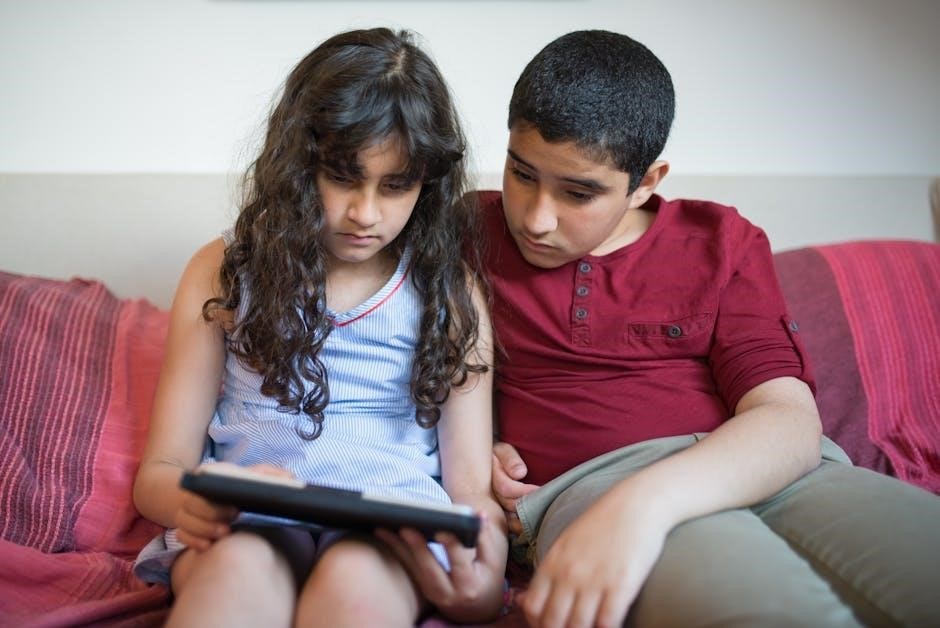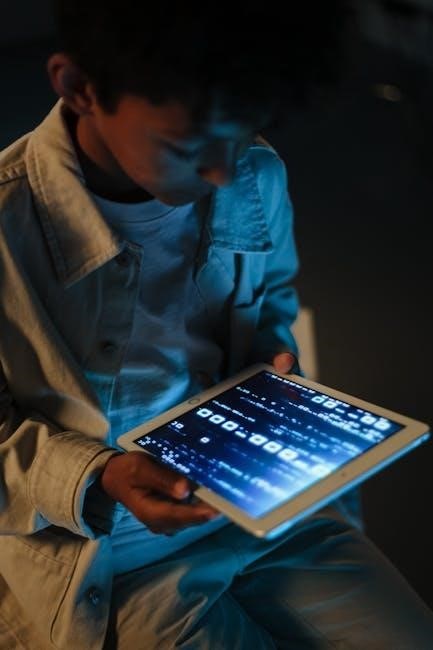Instructional technology integrates various media formats to enhance teaching and learning processes, empowering educators and students with innovative tools for improved educational outcomes and engagement.
1.1 Definition and Scope of Instructional Technology
Instructional technology refers to the use of technology and media to enhance teaching and learning processes. It encompasses tools, methods, and strategies to integrate technology into educational settings. The scope includes hardware, software, and multimedia resources, as well as systematic approaches to improve instructional practices. According to a 1998 study by the SouthEast and Islands Regional Technology in Education Consortium, it involves assessing and optimizing technology integration for effective education management and delivery.
- Includes tools like computers, educational software, and multimedia.
- Focuses on improving teaching, learning, and administrative tasks.
- Encourages innovative approaches to education through technology.
1.2 The Role of Media in Learning Processes
Media plays a pivotal role in learning by providing diverse formats like videos, animations, and interactive games. These resources engage students and cater to different learning styles. Teachers at Forest Lake use computers and whiteboards to access instructional videos and audio clips, enhancing classroom experiences. Media tools also facilitate self-directed learning and collaboration, aiding students in developing research skills and critical thinking; Effective use of media fosters an interactive and immersive educational environment.
- Enhances engagement through visual and auditory content.
- Supports diverse learning styles and preferences.
- Facilitates collaboration and self-directed learning.
1.3 Historical Evolution of Instructional Technology
Instructional technology has evolved significantly, starting with audio-visual tools in the early 20th century. The 1950s introduced radio and television for education, while the 1980s brought computers and CD-ROMs. The internet in the 1990s revolutionized access to information, leading to e-learning platforms. Today, advancements like AI, VR, and mobile devices continue to shape learning experiences, making education more accessible and interactive.
- Early tools: Films, projectors, and radio.
- 1980s: Computers and multimedia integration.
- Modern era: Internet and mobile learning.

Benefits of Instructional Technology in Education
Instructional technology enhances learning by increasing accessibility, personalization, and engagement. It fosters efficiency, bridges gaps, and prepares students for a rapidly changing, tech-driven world.
- Enhances accessibility and inclusivity.
- Supports personalized learning paths.
- Boosts student engagement and outcomes.
2.1 Enhanced Access to Information and Resources
Instructional technology bridges gaps by providing instant access to vast resources. Digital libraries, online databases, and educational platforms offer diverse materials, enabling learners to explore topics deeply. Tools like translation services and text-to-speech further inclusivity, ensuring equitable learning opportunities. This accessibility fosters a culture of continuous learning and intellectual growth.
- 24/7 access to learning materials.
- Diverse resources cater to varied learning needs.
- Breaking geographical and language barriers.
2.2 Personalized Learning Experiences
Instructional technology enables tailored learning paths, catering to individual needs and preferences. Adaptive software adjusts content difficulty, while Learning Management Systems track progress. Multimedia resources engage diverse learning styles, fostering deeper understanding. Data analytics identify knowledge gaps, allowing targeted interventions. This customization enhances efficiency and satisfaction, ensuring each learner achieves their potential.
- Adaptive software tailors content to individual needs.
- Learning Management Systems track progress and engagement.
- Data-driven insights guide personalized interventions.
2.3 Improved Engagement and Motivation in Students
Instructional technology fosters engagement by making learning interactive and immersive. Multimedia elements like videos, simulations, and gamification captivate students, increasing participation. Real-time feedback and collaborative tools enhance motivation, while personalized challenges encourage active involvement. These dynamic approaches create a stimulating environment, making learning enjoyable and boosting student enthusiasm for academic success.
- Interactive elements increase student participation.
- Real-time feedback motivates learners.
- Collaborative tools enhance engagement.

Key Frameworks for Technology Integration
Frameworks like TPACK, SAMR, and ADDIE provide structured approaches to integrate technology effectively, guiding educators to enhance teaching and learning experiences with innovative tools.
3.1 The TPACK (Technological Pedagogical Content Knowledge) Framework
TPACK emphasizes the integration of technological knowledge (TK), pedagogical knowledge (PK), and content knowledge (CK) to create effective learning experiences. By understanding how these elements intersect, educators can design engaging, technology-enhanced lessons that align with learning objectives and address diverse student needs. This framework ensures that technology is not merely added but thoughtfully integrated to enhance teaching and learning outcomes.
3.2 SAMR Model for Effective Technology Integration
The SAMR Model categorizes technology integration into four levels: Substitution, Augmentation, Modification, and Redefinition. Substitution involves replacing traditional tools with digital ones, while Augmentation enhances tasks with new features. Modification significantly changes the task design, and Redefinition enables entirely new learning experiences. This framework helps educators progress from basic to transformative technology use, fostering deeper engagement and understanding in the learning process.
3.3 The ADDIE Model for Instructional Design
The ADDIE Model is a systematic approach to instructional design, consisting of five phases: Analyze, Design, Develop, Implement, and Evaluate. It ensures alignment of learning objectives with content and assessment. This framework guides educators in creating structured, engaging, and effective learning experiences, making it a cornerstone in instructional technology for achieving measurable educational outcomes.

Tools and Media for Instructional Technology
Instructional technology utilizes diverse tools like educational software, multimedia resources, and interactive boards to enhance learning. These tools promote engagement, interactivity, and visually enriched educational experiences.
4.1 Educational Software and Applications
Educational software and apps are essential tools for instructional technology, offering interactive learning experiences; Platforms like learning management systems (LMS), educational games, and simulation tools enhance engagement. Apps such as Duolingo and Khan Academy provide personalized learning paths, while software like GeoGebra offers interactive simulations for STEM subjects. These tools make learning accessible, fun, and effective, catering to diverse learning styles and fostering deeper understanding through hands-on activities and real-time feedback.
4.2 Multimedia Resources (Videos, Audio, Animations)
Multimedia resources, such as videos, audio, and animations, enrich learning experiences by engaging multiple senses. Videos clarify complex concepts visually, while audio enhances auditory learning. Animations simplify abstract ideas, making them relatable. These resources cater to diverse learning styles and increase student engagement. They also support self-paced learning and provide accessible alternatives for students with disabilities, fostering inclusivity in educational settings.
4.3 Interactive Whiteboards and Smart Boards
Interactive whiteboards and smart boards enhance learning by combining hardware and software for dynamic, collaborative experiences. They support touch interactions, real-time collaboration, and integration of multimedia content. These tools enable teachers to create engaging lessons, while students can actively participate through touch or digital inputs. They also facilitate immediate feedback and assessment, making them versatile tools for modern classrooms.

Digital Literacy and Search Skills for Students
Digital literacy empowers students to effectively navigate and evaluate online information. Essential skills include critical thinking, media literacy, and safe online practices to make informed decisions.
5.1 Teaching Effective Internet Search Strategies
Teaching effective internet search strategies involves guiding students to use Boolean operators, evaluate sources, and organize information. Educators emphasize critical thinking to distinguish credible sources from misinformation. Practical exercises, such as keyword selection and advanced search techniques, enhance proficiency. These skills empower students to efficiently locate relevant, reliable content, fostering independent learning and academic success in a digital age.
5.2 Using Search Engines and Hashtags for Research
Using search engines and hashtags effectively enhances research efficiency. Students learn to leverage Boolean operators and advanced search features to refine results. Hashtags help track trends and locate niche topics on social platforms. Educators teach techniques to organize and filter information, ensuring focused and credible outcomes. This skill fosters better research practices and improves digital literacy in an information-rich world.
5.3 Navigating Social Media for Educational Purposes
Social media platforms offer valuable educational tools when used strategically. Educators and students can leverage platforms like Twitter, LinkedIn, and Pinterest to access resources, connect with experts, and engage in learning communities. Using hashtags like #EdTech or #Education helps discover relevant content and trends. However, it’s crucial to teach critical thinking to discern credible sources and avoid distractions, ensuring social media enhances rather than hinders learning.

Classroom Applications of Instructional Technology
Instructional technology transforms traditional teaching methods by integrating digital tools, fostering interactive learning environments, and enhancing student engagement through personalized experiences and innovative resources.
6.1 Flipped Classroom Models
The flipped classroom model reverses traditional lecture-homework formats by delivering instructional content at home via pre-recorded videos or readings. Class time is dedicated to interactive activities, group work, and personalized instruction. This approach enhances engagement, allows for real-time feedback, and caters to diverse learning needs, making it a powerful application of instructional technology in modern education settings.
6.2 Blended Learning Approaches
Blended learning combines traditional face-to-face instruction with digital tools, offering flexibility and personalized learning experiences. Students engage with online content at their own pace, while classroom time focuses on interactive activities and collaboration. This approach enhances engagement, provides real-time feedback, and accommodates diverse learning styles, making it a versatile and effective instructional strategy in modern educational settings.
6.3 Gamification of Learning Processes
Gamification of learning processes integrates game mechanics into educational activities, enhancing engagement and motivation. By incorporating elements like points, badges, and leaderboards, students experience increased interaction and participation. This approach fosters a competitive yet supportive environment, encouraging active learning. Teachers can design gamified lessons to align with curriculum goals, improving student outcomes and overall educational experiences effectively.

Challenges and Limitations of Instructional Technology
Balancing technology integration with traditional methods remains a challenge, alongside issues like digital divide, accessibility barriers, and the need for continuous teacher training and infrastructure updates.
7.1 Digital Divide and Accessibility Issues
The digital divide refers to disparities in access to technology, affecting educational opportunities. Limited access to devices and internet connectivity hinders students’ ability to engage with digital learning resources. Additionally, accessibility barriers, such as lack of accommodations for disabilities, further marginalize certain groups. Addressing these issues is crucial for ensuring equitable education and maximizing the benefits of instructional technology for all learners.
7.2 Information Overload and Credibility Concerns
The abundance of digital content often leads to information overload, making it difficult for students to focus and discern relevant material. Additionally, the credibility of online sources is a growing concern, as misinformation and bias can hinder learning. Educators must teach students to evaluate sources critically and use tools to filter reliable information effectively.
- Teaching critical thinking skills is essential to combat misinformation.
- Encouraging the use of credible databases and fact-checking websites helps students navigate information overload.
7.3 Balancing Technology Use in the Classroom
Balancing technology use in the classroom ensures learning remains engaging without overwhelming students; Educators should set clear boundaries, such as screen time limits and focused digital activities, to maintain a healthy mix of traditional and tech-based teaching methods. This balance fosters a more inclusive and effective learning environment, preventing technology from overshadowing essential interpersonal interactions and hands-on experiences.
- Encourage reflective practice to evaluate tech integration.
- Align technology use with specific learning objectives.
Emerging Trends in Instructional Technology
Emerging trends include microlearning, gamification, and voice-activated interfaces, reshaping education with personalized, interactive, and accessible learning experiences that cater to diverse student needs.
8.1 Artificial Intelligence (AI) in Education
AI revolutionizes education through personalized learning, intelligent tutoring systems, and automated grading. It enhances accessibility by providing real-time feedback and adaptive learning paths, addressing diverse student needs. Tools like natural language processing and machine learning enable tailored resources, fostering engagement and efficiency. AI also supports educators by streamlining administrative tasks, allowing more focus on teaching and innovation, ultimately creating a more inclusive and dynamic learning environment.
8.2 Virtual and Augmented Reality (VR/AR) in Learning
Virtual and Augmented Reality (VR/AR) transform learning by creating immersive, interactive experiences. VR enables students to explore virtual environments, such as historical sites or molecular structures, while AR overlays digital content onto real-world objects. These technologies enhance engagement, improve retention, and provide hands-on practice for complex skills, making abstract concepts more accessible and memorable. They also offer personalized learning opportunities, catering to diverse learning styles and needs.
8.3 Big Data and Analytics in Educational Settings
Big Data and analytics are revolutionizing education by providing insights into student behavior, performance, and learning patterns. By analyzing vast amounts of data, educators can identify trends, predict outcomes, and tailor interventions. These tools enable personalized learning, optimize resource allocation, and improve decision-making. Analytics also help track progress, detect at-risk students, and refine teaching strategies, ultimately enhancing educational efficiency and student success.

The Role of Educators in Implementing Instructional Technology
Educators act as facilitators, guiding both students and peers in integrating technology. They must stay updated on tools and methodologies. Professional development is essential.
9.1 Professional Development for Teachers
Professional development is crucial for educators to effectively integrate instructional technology. Training programs, workshops, and online courses help teachers master new tools and methodologies. Collaboration with tech experts and peers fosters innovation. Continuous learning ensures educators stay updated on emerging trends, enabling them to create engaging, tech-enhanced lesson plans that cater to diverse learning needs and enhance student outcomes.
9.2 Encouraging Student-Centered Learning
Instructional technology supports student-centered learning by empowering learners to take control of their education. Adaptive software and multimedia resources enable personalized learning paths, allowing students to explore topics at their own pace. Interactive simulations and collaborative tools foster engagement and critical thinking, while multimedia projects encourage creativity. This approach ensures students are active participants, not passive recipients, in the learning process, preparing them for lifelong skill development and independence.
9.3 Fostering Collaboration and Innovation
Instructional technology fosters collaboration and innovation by providing tools that connect learners globally. Online platforms enable shared projects, while multimedia presentations and digital whiteboards promote brainstorming. Collaborative software encourages teamwork, and interactive simulations spark creative problem-solving. By integrating these tools, educators create environments where students can innovate, share ideas, and learn from one another, preparing them to thrive in a collaborative and tech-driven world.
Global Perspectives on Instructional Technology
Global perspectives highlight diverse approaches to instructional technology, emphasizing collaboration and cultural considerations. Countries adapt tools to local needs, fostering innovation and addressing challenges like access and equity.
10.1 International Case Studies and Success Stories
International case studies reveal innovative uses of instructional technology, such as South Korea’s virtual classrooms and Kenya’s mobile learning initiatives. These examples demonstrate how nations adapt technology to improve education, fostering collaboration and cultural exchange. Success stories highlight improved learning outcomes, increased access, and enhanced digital literacy, showcasing the global potential of instructional technology to transform education.
10.2 Cultural Considerations in Technology Integration
Cultural considerations are vital when integrating technology in education, as they influence how learners interact with and perceive digital tools. Educators must adapt technologies to align with local values, languages, and traditions. For instance, translating content and incorporating regional examples can enhance relevance. Respecting cultural norms ensures technology is accessible and meaningful, fostering inclusive learning environments and promoting cross-cultural understanding in diverse educational settings.
10.3 United Nations Sustainable Development Goals (SDGs) and Education
The United Nations Sustainable Development Goals (SDGs) emphasize the importance of quality education for all. Instructional technology plays a critical role in achieving SDG 4 by expanding access to education, reducing disparities, and enhancing learning outcomes. Tools like AI, virtual classrooms, and digital resources support inclusive and equitable education, aligning with the SDGs’ vision of a sustainable and educated global society.

Evaluating the Effectiveness of Instructional Technology
Evaluating instructional technology involves assessing its alignment with learning goals, impact on student outcomes, and overall value. Data-driven approaches ensure informed decisions and continuous improvement in education.
11.1 Assessment Tools and Methods
Various tools like quizzes, surveys, and analytics track student progress. Simulations and interactive content assess practical skills. Portfolio evaluations provide insight into comprehensive learning. These methods ensure objective measurement of knowledge retention and skill mastery, aiding in data-driven decision-making to enhance instruction and student outcomes effectively.
11.2 Measuring Learning Outcomes and Engagement
Educators use quizzes, assignments, and project submissions to evaluate learning outcomes. Engagement is measured through participation metrics, such as discussion forum activity and interactive module completion rates. Learning Management Systems (LMS) provide analytics to track student progress and identify areas needing improvement. These tools help assess comprehension, retention, and active involvement, ensuring alignment with instructional goals and fostering data-driven teaching strategies.
11.3 Continuous Improvement Strategies
Educators continuously improve instructional technology by analyzing data and student feedback, refining methods to meet learning objectives. Professional development and technology integration are key strategies. These approaches enhance teaching effectiveness and student engagement. By adapting to different learning environments and promoting collaboration, educators align with educational goals and stay updated with technological advancements, optimizing resource allocation for better outcomes.

The Future of Instructional Technology and Media
The future of instructional technology involves AI-driven tools, adaptive learning, and immersive experiences like VR/AR. These innovations will reshape education, making it more personalized, accessible, and engaging for all learners.
12.1 Predictions and Trends for the Next Decade
The next decade will see exponential growth in AI-driven adaptive learning, personalized education, and immersive technologies like VR/AR. These tools will revolutionize how students engage with content, making learning more interactive and tailored to individual needs.
5G connectivity and advancements in big data will enable seamless access to high-quality educational resources globally. Microlearning and gamification will also rise, fostering shorter, focused learning experiences that enhance retention and motivation.
12.2 Preparing Students for a Tech-Driven World
Preparing students for a tech-driven world involves fostering digital literacy, critical thinking, and problem-solving skills. Schools must integrate emerging technologies like AI, coding, and data analysis to equip students with future-ready competencies. Emphasizing ethical tech use and collaboration will ensure students navigate a rapidly evolving landscape responsibly and effectively.
By aligning education with technological advancements, students will gain the adaptability and innovation skills needed to thrive in tomorrow’s workforce.
12.3 Ethical Considerations in Educational Technology
Ethical considerations in educational technology focus on ensuring equitable access, protecting student data, and promoting responsible use. Privacy concerns, particularly with AI and data analytics, must be addressed to maintain trust. Educators should also prioritize transparency in how technologies are implemented and used. Addressing biases in AI-driven tools and fostering digital citizenship are critical to creating a fair and ethical learning environment for all students.

